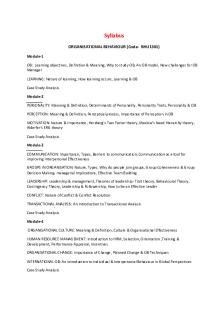Week2notes - Full Notes of live lectures PDF

| Title | Week2notes - Full Notes of live lectures |
|---|---|
| Course | Coding Practicum |
| Institution | DeVry University |
| Pages | 2 |
| File Size | 58.7 KB |
| File Type | |
| Total Downloads | 20 |
| Total Views | 129 |
Summary
Full Notes of live lectures...
Description
WEEK 2 LIVE LECTURE NOTES
Incidental Findings: Incidental findings are abnormal findings related to why the exam was performed not the reason and can be discovered during the examination. Incidental findings may be codes. After all clinically significant findings are reported which is typically defined by theat organizational policy. Incidental findings should never be listed as primary diagnosis; it may be reported as secondary diagnosis. Sometimes we have to see the category.
Outpatient Care: Outpatient care also known as Ambulatory care. Determines which coding guidelines we use. Its important to know when patient status is outpatient because it determines which coding guidelines we use; we use sections for outpatient coding guidelines and it also determines what procedure code system we are going to use; we will use CPT for any patient setting that has a procedure. Types of outpatient: Ambulatory outpatient, Ambulatory surgery, Emerging care and observation. It's important to know the status of the patient.
Outpatient diagnostic Coding and Reporting Guidelines: Coding guidelines were developed by the federal government. They are used by hospitals and providers when reporting hospital based outpatient services and outpatient counters. Could be used in any kind of outpatient setting. It was developed for government claims like medicare but most or almost all insurers now require that you follow this coding guidelines.
Section of First Listed Conditions: First listed diagnosis is a diagnosis, condition, problem or other reason that brings a patient to seek care. So make sure to see what brings in patients for care. If we don't have a definitive diagnosis it can be a sign or a symptom. The terms Encounter Visit are used interchangeably. Outpatient setting Ambulatory surgery center can be clinic, hospital clinic or can be physician cilic, emergency department, same day surgery, observation, this is the outpatient setting.
Sequencing: If the surgery is cancelled we still use that as a reason for the outpatient category but we also add a secondary code Z53 from the category that tells us why the surgery wasn't performed. Code should tell the story between the treatment and care provided to the patient. Observation: There will be the patient who will be for observation post or pre surgery to see there are no complications after or before the surgery. So we code the reason for the surgeon and then we report any complications as a secondary diagnosis. Do not use the qualified diagnosis. Diagnoses documented as portable, suspected, questionable, rule out or working or other similar terms indicating uncertainty ICD call this as qualified diagnosis. Anything that indicates uncertainty we instead code to the highest degree of certainty....
Similar Free PDFs

FULL Notes
- 229 Pages

Full notes
- 102 Pages

Lecture notes - all lectures
- 130 Pages

Lecture notes - All lectures
- 41 Pages

Lecture notes - all lectures
- 54 Pages
Popular Institutions
- Tinajero National High School - Annex
- Politeknik Caltex Riau
- Yokohama City University
- SGT University
- University of Al-Qadisiyah
- Divine Word College of Vigan
- Techniek College Rotterdam
- Universidade de Santiago
- Universiti Teknologi MARA Cawangan Johor Kampus Pasir Gudang
- Poltekkes Kemenkes Yogyakarta
- Baguio City National High School
- Colegio san marcos
- preparatoria uno
- Centro de Bachillerato Tecnológico Industrial y de Servicios No. 107
- Dalian Maritime University
- Quang Trung Secondary School
- Colegio Tecnológico en Informática
- Corporación Regional de Educación Superior
- Grupo CEDVA
- Dar Al Uloom University
- Centro de Estudios Preuniversitarios de la Universidad Nacional de Ingeniería
- 上智大学
- Aakash International School, Nuna Majara
- San Felipe Neri Catholic School
- Kang Chiao International School - New Taipei City
- Misamis Occidental National High School
- Institución Educativa Escuela Normal Juan Ladrilleros
- Kolehiyo ng Pantukan
- Batanes State College
- Instituto Continental
- Sekolah Menengah Kejuruan Kesehatan Kaltara (Tarakan)
- Colegio de La Inmaculada Concepcion - Cebu










